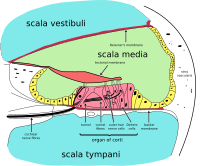
Photo from wikipedia
Objective Different types of bone conduction transducers with different physical and electro-acoustic properties are available for audiometric hearing threshold measurements. The reference equivalent threshold vibratory force levels (RETVFL) specified in… Click to show full abstract
Objective Different types of bone conduction transducers with different physical and electro-acoustic properties are available for audiometric hearing threshold measurements. The reference equivalent threshold vibratory force levels (RETVFL) specified in ISO 389–3 are based on measurements conducted with the B71 and KH70 transducers but apply to all types of transducers available for bone conduction audiometry. The objective of this study was to compare bone conduction hearing thresholds measured by different transducers. Design In a prospective study the hearing thresholds were measured psychometrically between 125 Hz and 8000 Hz using the Radioear B71, B81 and Präcitronic KH70 transducers. Study sample Twenty-one normal hearing participants and fifteen hearing impaired participants. Results In both groups significant differences were found between the thresholds measured with the different transducers at the low frequencies 125 Hz and 250 Hz and the high frequencies 3000 Hz, 4000 Hz, 6000 Hz and 8000 Hz. In the normal hearing group, deviations from the reference threshold 0 dB HL towards lower thresholds were observed for the B71 and B81 at 125 Hz and at the high frequencies 3000 Hz, 4000 Hz, 6000 Hz and 8000 Hz. Conclusions RETVFL-values should be reassessed and provided specifically for the different transducers.
Journal Title: PLoS ONE
Year Published: 2018
Link to full text (if available)
Share on Social Media: Sign Up to like & get
recommendations!